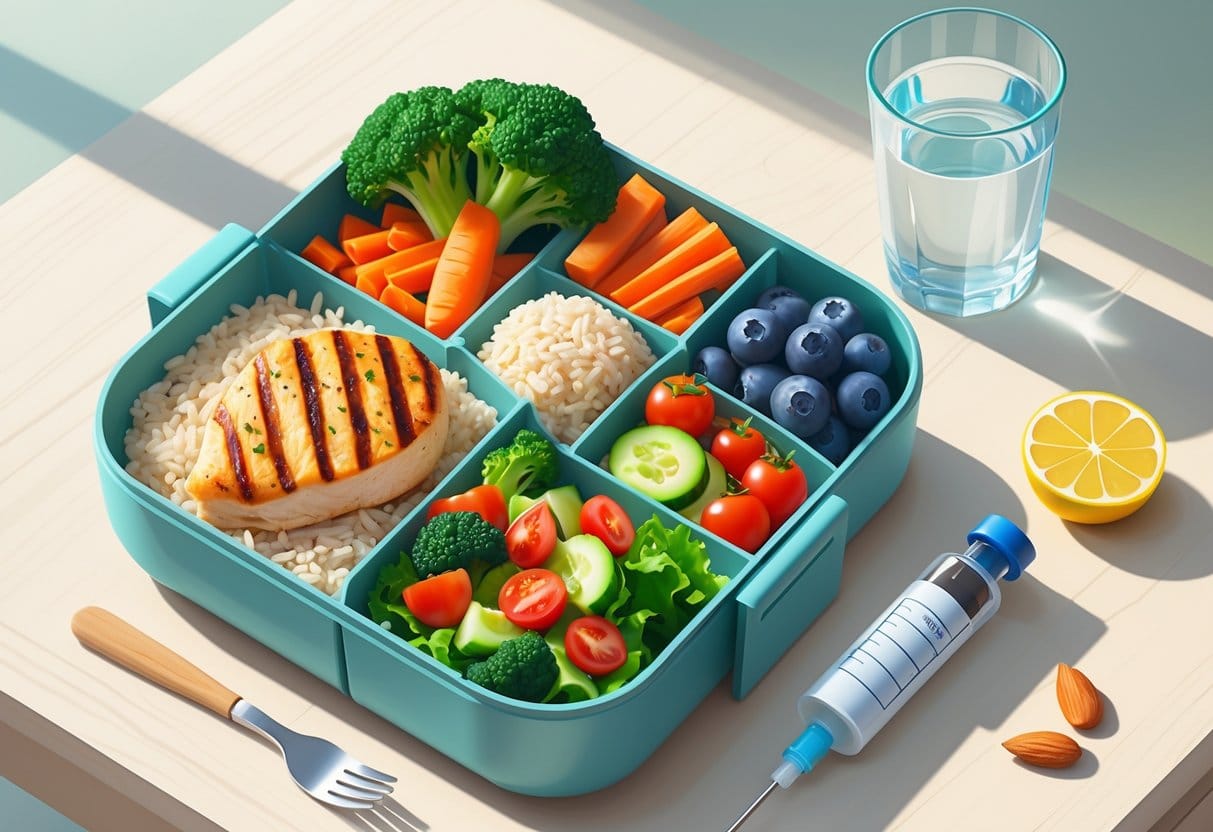Building a balanced diabetic lunchbox doesn’t have to be overwhelming. The trick is to include lean proteins, complex carbs, fiber-rich veggies, healthy fats, and just enough fruit.
All these parts work together. They help manage blood sugar and keep you feeling satisfied for longer.

When you’re planning lunch, try filling half your lunchbox with colorful veggies and fruits. One-quarter should be whole grains or other complex carbs, and the rest, a solid source of protein.
Healthy fats are important too. They help keep your energy steady through the afternoon.
Key Takeaways
- A balanced lunch has protein, complex carbs, veggies, fruit, and healthy fats.
- Portion control and variety make it easier to manage blood sugar.
- A well-packed lunch means steadier energy and healthier habits.
Key Components of a Balanced Diabetic Lunchbox
A good lunchbox for diabetes brings together nutrients that support blood sugar control and keep you energized. Lean proteins, fiber-rich fruits and veggies, and whole grains are the main players.
Choosing the Right Proteins
Protein helps keep blood sugar stable and you’ll feel full longer. Go for lean proteins like grilled chicken, turkey, or fish.
Plant-based picks—beans, lentils, tofu—are solid too. They add fiber along with protein.
Skip processed meats that sneak in extra sugar or unhealthy fats. Small amounts of cheese or nuts can boost protein and add healthy fats.
Just keep your protein choice within your calorie and carb goals.
Incorporating Fruits and Vegetables
Fruits and veggies add fiber, vitamins, and minerals. Pick two or three different kinds for lunch—maybe apples, baby carrots, or some leafy greens.
Fresh or frozen veggies are both good. For fruit, stick to options without added sugar, like berries or apple slices.
Raw or lightly cooked veggies work best. Try to avoid starchy ones like potatoes or corn to help keep carbs in check.
Opting for Whole Grains
Whole grains give you fiber and steady energy. They’re better for blood sugar than refined grains.
Think whole grain crackers, brown rice, quinoa, or whole wheat bread. White bread and refined starches can spike blood sugar, so it’s best to avoid those.
Whole grains have more nutrients and help you feel full. Just watch your portions to keep carbs under control.
Smart Packing Strategies
Having a plan when you pack lunch makes it easier to manage blood sugar and enjoy your meals. Mix up food groups, keep portions in check, and pick snacks that support steady energy.
Building a Well-Rounded Lunch
Include protein, whole grains, fruits, and veggies in your lunch box. Grilled chicken, boiled eggs, or almonds are good protein choices.
Whole grains like whole-wheat bread or brown rice provide lasting energy. Add in colorful veggies for vitamins and fiber.
Carrots, cucumber slices, or a little salad fit nicely. Fruit like apples or berries brings natural sweetness without messing with your blood sugar too much.
Processed foods with lots of sugar or unhealthy fats aren’t the best bet. Instead, go for foods you actually like that also meet your health needs.
Balancing Portion Sizes
Portion control really matters. Use your hand as a rough guide—a fist for veggies, a palm for protein, and a cupped handful for grains.
This helps prevent overeating and keeps blood sugar steadier. Packing your lunch in containers or small bags makes it easier to measure before you head out.
If you want to include a treat like granola, just keep the serving small. A tablespoon or two is plenty as a topping or snack.
Healthy Snack Options
Pick snacks that bring fiber, protein, and healthy fats. Roasted chickpeas, popcorn, or a handful of almonds are solid choices.
Skip the candy or chips. Instead, try crunchy veggie crisps or fruit with peanut butter.
Peanut butter can also help stick raisins or other small snacks together—kind of fun, honestly, and good for blood sugar too.
Make snacks easy to eat and already portioned. Having these options in your lunchbox helps you stay full through the day.
Supporting a Healthy Lifestyle
Balancing your lunch with the right foods is just one piece of the puzzle. Your daily habits—especially staying active—matter a lot for blood sugar and overall health.
Pairing Meals with Exercise
When you’re planning lunch, it’s worth thinking about your workout schedule. Eating lean proteins and complex carbs before or after exercise can help fuel your body and keep your blood sugar steady.
Let’s say you go for grilled chicken, brown rice, and some broccoli. That combo gives you solid, lasting energy for whatever activity you’ve got lined up.
Try to eat about one to two hours before you exercise. That way, your body actually has time to digest and soak up the nutrients.
After you finish working out, go for meals that help your muscles recover—just don’t pick stuff that’ll send your blood sugar on a rollercoaster.
Drinking water is always a good move. Toss in some healthy fats like avocado or a handful of nuts, and you’ll probably feel fuller, longer.
You might need to tweak your lunch depending on how tough or long your workout is. It’s a bit of trial and error, honestly, but it helps keep your blood sugar on track.